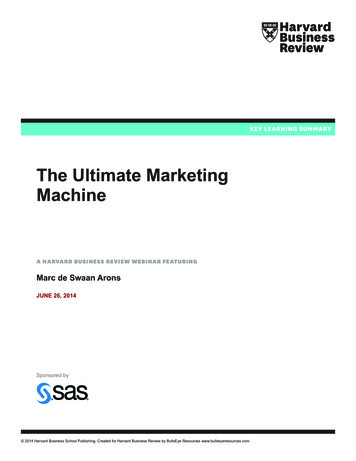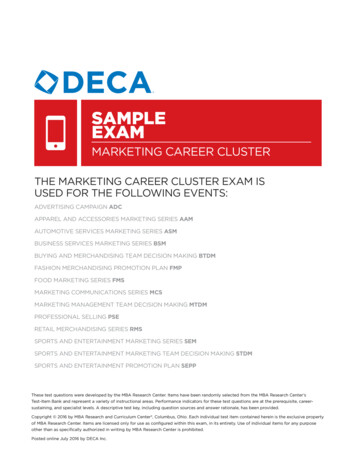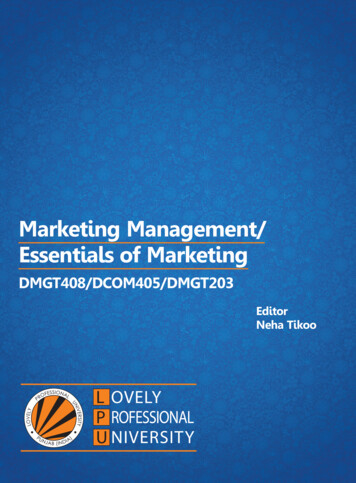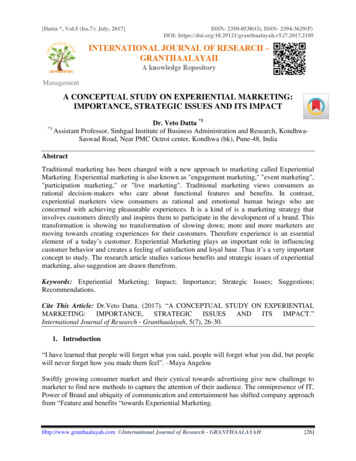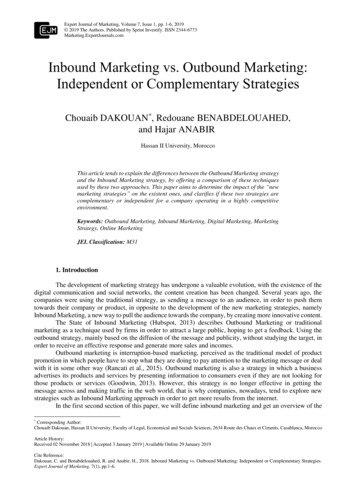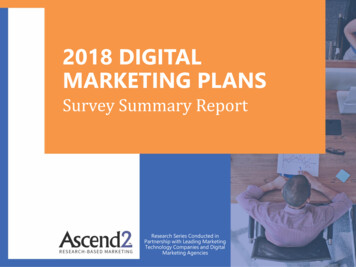
Transcription
Part 1: Introduction to Marketing ManagementChapter 1Scope of Marketing forNew RealitiesIn this chapter, we will address the following questions:1. Why is marketing important? (Page 26)2. What is the scope of marketing? (Page 26)3. What are some core marketing concepts? (Page 29)4. What forces are defining the new marketing realities? (Page 31)5. What tasks are necessary for successful marketing management? (Page 34)Marketing Management at UnileverUnder the leadership of ex-P&G marketing executive Paul Polman and marketing whiz KeithWeed, Unilever is steering in an aggressive new direction. Its “Crafting Brands for Life” model establishes social, economic, and product missions for each brand, including Dove, Ben & Jerry’s, andKnorr. One part of the mission, for instance, is sustainability—specifically, to halve its ecologicalfootprint while doubling revenues. To improve marketing communications, it aims to strike a balance between “magic” and “logic,” doubling marketing training expenditures and emphasizing adresearch. Unilever has set its sights on developing and emerging markets, hoping to draw 70 percentto 75 percent of revenues from these markets by 2020. The company has also adopted “reverse innovation” by applying marketing innovations from developing markets to recession-hit developedmarkets. In Spain, it now sells Surf detergent in five-wash packs. In Greece, it offers mayonnaise insmall packages.1Good marketing is no accident. It is both an art and a science, and it results from careful planning and execution using state-of-the-art tools and techniques. In this book, we describehow skillful marketers are updating classic practices and inventing new ones to find creative,25
26Part 1 Introduction to Marketing Managementpractical solutions to new marketing realities. In the first chapter, we lay our foundation by reviewing important marketing concepts, tools, frameworks, and issues.The Value of MarketingFinance, operations, accounting, and other business functions won’t really matter without sufficient demand for products and services so the firm can make a profit. In other words, there mustbe a top line for there to be a bottom line. Thus, financial success often depends on marketingability. Marketing’s value extends to society as a whole. It has helped introduce new or enhancedproducts that ease or enrich people’s lives. Successful marketing builds demand for products andservices, which, in turn, creates jobs. By contributing to the bottom line, successful marketingalso allows firms to more fully engage in socially responsible activities.2Many firms, even service and nonprofit, now have a chief marketing officer (CMO) to putmarketing on a more equal footing with other C-level executives such as the chief financial officer(CFO) or chief information officer (CIO).3 In an Internet-fueled environment where consumers,competition, technology, and economic forces change rapidly and consequences quickly multiply,marketers in every organization must choose features, prices, and markets and decide how muchto spend on advertising, sales, and online and mobile marketing—while under intense pressure tomake every marketing dollar count.At greatest risk are those that fail to carefully monitor their customers and competitors,continuously improve their value offerings and marketing strategies, or satisfy their employees,stockholders, suppliers, and channel partners in the process. Thus, skillful marketing is a neverending pursuit. Despite these challenges, some businesses are adapting and thriving in thesechanging times.The Scope of MarketingTo be a marketer, you need to understand what marketing is, how it works, who does it, and whatis marketed.What Is Marketing?Marketing is about identifying and meeting human and social needs. One of the shortest gooddefinitions of marketing is “meeting needs profitably.” When Google recognized that peopleneeded to more effectively and efficiently access information on the Internet, it created a powerful search engine that organized and prioritized queries. When IKEA noticed that people wantedgood furnishings at substantially lower prices, it created knockdown furniture. These two firmsdemonstrated marketing savvy and turned a private or social need into a profitable businessopportunity.The American Marketing Association offers the following formal definition: Marketingis the activity, set of institutions, and processes for creating, communicating, delivering, andexchanging offerings that have value for customers, clients, partners, and society at large.4 Wesee marketing management as the art and science of choosing target markets and getting,keeping, and growing customers through creating, delivering, and communicating superior customer value. Cocreation of value among consumers and with businesses and the importanceof value creation and sharing have become important themes in the development of modernmarketing thought.5Note that selling is not the most important part of marketing. Peter Drucker, famed management theorist, says that “the aim of marketing is to know and understand the customer so well
Chapter 1 Scope of Marketing for New Realitiesthat the product or service fits him and sells itself. Ideally, marketing should result in a customerwho is ready to buy. All that should be needed then is to make the product or service available.”6When Apple launched its iPad tablet computer and when Toyota introduced its Prius hybridautomobile, these manufacturers were swamped with orders because they designed the rightproduct, based on careful marketing homework.What Is Marketed?Marketers market 10 main types of entities: goods, services, events, experiences, persons, places,properties, organizations, information, and ideas.Goods Physical goods constitute the bulk of most countries’ production and marketing efforts. Each year, U.S. companies market billions of fresh, canned, bagged, and frozen food products and other tangible items.Services As economies advance, a growing proportion of their activities focuses on theproduction of services. The U.S. economy today produces a services-to-goods mix of roughlytwo-thirds to one-third.7 Services include the work of airlines, hotels, car rental firms, barbersand beauticians, maintenance and repair people, and accountants, bankers, lawyers, engineers,doctors, software programmers, and management consultants. Many market offerings mix goodsand services, such as a fast-food meal.Events Marketers promote time-based events, such as major trade shows, artistic performances, and company anniversaries. Global sporting events such as the Olympics and the WorldCup are promoted aggressively to companies and fans.Experiences By orchestrating several services and goods, a firm can create, stage, and marketexperiences. Walt Disney World’s Magic Kingdom lets customers visit a fairy kingdom, a pirateship, or a haunted house. Customized experiences include a week at a baseball camp with retiredbaseball greats, as one example.8Persons Artists, musicians, CEOs, physicians, high-profile financiers, and other professionalsoften get help from marketers.9 Management consultant Tom Peters, himself a master at selfbranding, has advised each person to become a “brand.”Places Cities, states, regions, and whole nations compete to attract tourists, residents, factories, and company headquarters.10 Place marketers include economic development specialists,real estate agents, commercial banks, local business associations, and advertising and public relations agencies.Properties Properties are intangible rights of ownership to either real property (real estate)or financial property (stocks and bonds). They can be bought and sold and therefore requiremarketing through the efforts of real estate agents, investment companies, and banks.Organizations Museums, performing arts organizations, corporations, and nonprofits alluse marketing to boost their public images and compete for audiences and funds. Some universities have created chief marketing officer (CMO) positions to better manage their schoolidentity and image, via everything from admission brochures and Twitter feeds to brandstrategy.1127
28Part 1 Introduction to Marketing ManagementInformation Information is essentially what books, schools, and universities produce, market,and distribute at a price to parents, students, and communities.Ideas Every market offering includes a basic idea. Charles Revson of Revlon once observed:“In the factory we make cosmetics; in the drugstore we sell hope.” Products and services are platforms for delivering some idea or benefit. Social marketers promote such ideas as “Friends Don’tLet Friends Drive Drunk” and “A Mind Is a Terrible Thing to Waste.”Who Markets?A marketer is someone who seeks a response—attention, a purchase, a vote, a donation—fromanother party, called the prospect. If two parties are seeking to sell something to each other, wecall them both marketers.Increasingly, marketing is not done only by the marketing department. Marketers now mustproperly manage all possible touch points (where a customer directly or indirectly interacts withthe company), including store layouts, package designs, product functions, employee training,and shipping and logistics. To create a strong marketing organization, marketers must think likeexecutives in other departments, and executives in other departments must think more like marketers. Interdepartmental teamwork that includes marketers is needed to manage key processeslike production innovation, new-business development, customer acquisition and retention, andorder fulfillment.What Is a Market?Traditionally, a “market” was a physical place where buyers and sellers gathered to buy and sellgoods. Economists describe a market as a collection of buyers and sellers who transact over aparticular product or product class (such as the housing market or the grain market). Marketersuse the term market to describe customer groups. They talk about need markets (the dietseeking market), product markets (the shoe market), demographic markets (the “millennium”youth market), geographic markets (the Chinese market), or voter markets, labor markets, anddonor markets. Four key customer markets are consumer, business, global, and nonprofit.Figure 1.1 shows how sellers and buyers are connected by four flows. Sellers send goodsand services and communications such as ads and direct mail to the market; in return they receive money and information such as customer attitudes and sales data. The inner loop showsan exchange of money for goods and services; the outer loop shows an exchange of information.Figure 1.1 A Simple Marketing SystemCommunicationGoods/servicesMarket(a collection of buyers)Industry(a collection of sellers)MoneyInformation
Chapter 1 Scope of Marketing for New RealitiesCore Marketing ConceptsTo understand the marketing function, we need to understand the following core set of concepts.Needs, Wants, and DemandsNeeds are the basic human requirements such as for air, food, water, clothing, and shelter.Humans also have strong needs for recreation, education, and entertainment. These needs become wants when directed to specific objects that might satisfy the need. A U.S. consumer needsfood but may want a Chicago-style “deep-dish” pizza and a craft beer. A person in Afghanistanneeds food but may want rice, lamb, and carrots. Our wants are shaped by our society. Demandsare wants for specific products backed by an ability to pay. Many people want a Mercedes; onlya few can buy one. Companies must measure not only how many people want their product, butalso how many are willing and able to buy it.These distinctions shed light on the criticism that “marketers get people to buy things theydon’t want.” Marketers do not create needs: Needs pre-exist marketers. Marketers might promotethe idea that a Mercedes satisfies a person’s need for social status. They do not, however, createthe need for social status.Some customers have needs of which they are not fully conscious or that they cannot articulate. What does the customer mean in asking for a “powerful” lawn mower or a “peaceful” hotel?We can distinguish five types of needs:1.2.3.4.5.Stated needs (The customer wants an inexpensive car.)Real needs (The customer wants a car whose operating cost, not initial price, is low.)Unstated needs (The customer expects good service from the dealer.)Delight needs (The customer would like the dealer to include an onboard GPS system.)Secret needs (The customer wants friends to see him or her as a savvy consumer.)Responding only to the stated need may shortchange the customer.12 Consumers did notknow much about tablet computers when they were first introduced, but Apple worked hard toshape consumer perceptions of them. To gain an edge, companies must help customers learnwhat they want.Target Markets, Positioning, and SegmentationNot everyone likes the same cereal, restaurant, university, or movie. Marketers therefore identifydistinct segments of buyers by identifying demographic, psychographic, and behavioral differencesbetween them. They then decide which segment(s) present the greatest opportunities. For each ofthese target markets, the firm develops a market offering that it positions in target buyers’ minds asdelivering some key benefit(s). Porsche targets buyers who seek pleasure and excitement in drivingand want to make a statement about their wheels.Offerings and BrandsCompanies address customer needs by putting forth a value proposition, a set of benefits thatsatisfy those needs. The intangible value proposition is made physical by an offering, which canbe a combination of products, services, information, and experiences. A brand is an offeringfrom a known source. A brand name such as Apple carries many different kinds of associationsin people’s minds that make up its image: creative, innovative, easy-to-use, fun, cool, iPhone, andiPad to name just a few. All companies strive to build a brand image with strong, favorable, andunique brand associations.29
30Part 1 Introduction to Marketing ManagementMarketing ChannelsTo reach a target market, the marketer uses three kinds of marketing channels. Communicationchannels deliver and receive messages from target buyers and include newspapers, magazines, radio,television, mail, telephone, smart phone, billboards, posters, and the Internet. Firms also communicate through the look of their retail stores and Web sites and other media, adding dialogue channelssuch as e-mail, blogs, text messages, and URLs to familiar monologue channels such as ads.Distribution channels help display, sell, or deliver the physical product or service(s) to thebuyer or user. These channels may be direct via the Internet, mail, or mobile phone or telephoneor indirect with distributors, wholesalers, retailers, and agents as intermediaries. To carry outtransactions with potential buyers, the marketer also uses service channels that include warehouses, transportation companies, banks, and insurance companies. Marketers clearly face adesign challenge in choosing the best mix of communication, distribution, and service channels.Paid, Owned, and Earned MediaWe can group communication options for interacting with customers into three categories.13Paid media include TV, magazine and display ads, paid search, and sponsorships, all of whichallow marketers to show their ad or brand for a fee. Owned media are communication channelsmarketers actually own, like a company or brand brochure, Web site, blog, Facebook page, orTwitter account. Earned media are streams in which consumers, the press, or other outsidersvoluntarily communicate something about the brand via word of mouth, buzz, or viral marketing methods. The emergence of earned media has allowed some companies, such as Chipotle, toreduce paid media expenditures.14Impressions and EngagementMarketers now think of three “screens” or means to reach consumers: TV, Internet, and mobile.Impressions, which occur when consumers view a communication, are a useful metric for tracking the scope or breadth of a communication’s reach that can also be compared across all communication types. The downside is that impressions don’t provide any insight into the results ofviewing the communication. Engagement is the extent of a customer’s attention and active involvement with a communication, which is more likely to create value for the firm. Some onlinemeasures of engagements are Facebook “likes,” Twitter tweets, comments on a blog or Web site,and sharing of video or other content.Value and SatisfactionThe buyer chooses the offerings he or she perceives to deliver the most value, the sum of the tangible and intangible benefits and costs. Value, a central marketing concept, is primarily a combination of quality, service, and price, called the customer value triad. Value perceptions increasewith quality and service but decrease with price.Satisfaction reflects a person’s judgment of a product’s perceived performance in relationship to expectations. If performance falls short of expectations, the customer is disappointed. Ifit matches expectations, the customer is satisfied. If it exceeds them, the customer is delighted.Supply ChainThe supply chain is a longer channel stretching from raw materials to components to finishedproducts carried to final buyers. The supply chain for coffee may start with farmers whoplant, tend, and pick the coffee beans and sell their harvest. After farmers sell their harvest to
Chapter 1 Scope of Marketing for New Realitieswholesalers or perhaps a Fair Trade cooperative, the beans are prepared and then transported tothe developed world for sale through wholesale or retail channels. Each company in the chaincaptures only a certain percentage of the total value generated by the supply chain’s value delivery system. When a company acquires competitors or expands upstream or downstream, its aimis to capture a higher percentage of supply chain value.CompetitionCompetition includes all the actual and potential rival offerings and substitutes a buyer mightconsider. An automobile manufacturer can buy steel from U.S. Steel, from a firm in Japan orKorea, or from a mini-mill. Alternatively, it can buy aluminum parts from Alcoa to reduce thecar’s weight or engineered plastics instead of steel. Clearly, U.S. Steel is more likely to be hurt bysubstitute products than by other integrated steel companies and would be defining its competition too narrowly if it didn’t recognize this.Marketing EnvironmentThe marketing environment consists of the task environment and the broad environment. Thetask environment includes the actors engaged in producing, distributing, and promoting theoffering. These are the company, suppliers, distributors, dealers, and target customers. In thesupplier group are material suppliers and service suppliers, such as marketing research agencies, advertising agencies, banking and insurance companies, transportation companies, andtelecommunications companies. Distributors and dealers include agents, brokers, manufacturerrepresentatives, and others who facilitate finding and selling to customers.The broad environment consists of six components: demographic environment, economicenvironment, social-cultural environment, natural environment, technological environment,and political-legal environment. Marketers must pay close attention to the trends and developments in these and adjust their marketing strategies as needed.The New Marketing RealitiesThe marketplace is dramatically different from even 10 years ago, with new marketing behaviors,opportunities, and challenges emerging. In this book we focus on three transformative forces:technology, globalization, and social responsibility.TechnologyThe pace of change and the scale of technological achievement can be staggering. With therapid rise of e-commerce, the mobile Internet, and Web penetration in emerging markets,the Boston Consulting Group believes brand marketers must enhance their “digital balancesheets.”15 Massive amounts of information and data about almost everything are now available to consumers and marketers. In fact, the technology research firm Gartner predicts thatby 2017, chief marketing officers will spend more time on information technology than chiefinformation officers.The old credo “information is power” is giving way to the new idea that “sharing informationis power.”16 Even traditional marketing activities are profoundly affected by technology. As justone example, drug maker Roche decided to issue iPads to its entire sales team to improve salesforce effectiveness. Now sales personnel can do real-time data entry, improving the quality of thedata entered while freeing up time for other tasks.1731
32Part 1 Introduction to Marketing ManagementGlobalizationThe world has become a smaller place. New transportation, shipping, and communication technologies have made it easier for us to know the rest of the world, to travel, to buy and sell anywhere. By 2025, annual consumption in emerging markets will total 30 trillion and contributemore than 70 percent of global GDP growth.18 A staggering 56 percent of global financial services consumption is forecast to come from emerging markets by 2050, up from 18 percentin 2010.Globalization has made countries increasingly multicultural. U.S. minorities have much economic clout, and their buying power is growing faster than that of the general population. As aresult, one survey found that 87 percent of companies planned to increase or maintain multicultural media budgets.19 Companies can now take marketing ideas and lessons from one countryand apply them to another. After years of little success with premium ultrasound scanners in theChinese market, GE successfully developed a portable, ultra-low-cost version that addressed thecountry’s unique market needs. Later, it began to successfully sell the product throughout thedeveloped world for use in ambulances and operating rooms where existing units were too big.20Social ResponsibilityPoverty, pollution, water shortages, climate change, wars, and wealth concentration demand ourattention. The private sector is taking some responsibility for improving living conditions, andfirms all over the world have elevated the role of corporate social responsibility. Because marketing’s effects extend to society as a whole, marketers must consider the ethical, environmental,legal, and social context of their activities.21 “Marketing Insight: Getting to Marketing 3.0” describes how companies need to change to do that.A Dramatically Changed MarketplaceThese three forces—technology, globalization, and social responsibility—have dramaticallychanged the marketplace and provided both consumers and companies with new capabilities, asshown in Table 1.1.One of the reasons consumers have more choices is that channels of distribution havechanged. Store-based retailers face competition from catalog houses; direct-mail firms; newspaper, magazine, and TV direct-to-customer ads; home shopping TV; and e-commerce. InTable 1.1New Capabilities in the Changed MarketplaceNew Consumer Capabilities: Can use the Internet as a powerful information and purchasing aidCan search, communicate, and purchase on the moveCan tap into social media to share opinions and express loyaltyCan actively interact with companiesCan reject marketing they find inappropriateNew Company Capabilities: Can use the Internet as a powerful information and sales channel, including for individually differentiated goodsCan collect fuller and richer information about markets, customers, prospects, and competitorsCan reach customers quickly and efficiently via social media and mobile marketing, sending targeted ads, coupons,and informationCan improve purchasing, recruiting, training, and internal and external communicationsCan improve cost efficiency
Chapter 1 Scope of Marketing for New Realitiesmarketinginsight33Getting to Marketing 3.0Philip Kotler, Hermawan Kartajaya, and IwanSetiawan believe today’s customers want marketers to treat them as whole human beings andacknowledge that their needs extend beyond pureconsumerism. Successful marketing is thus distinguished by its human or emotional element. Athird wave of thinking, values-driven and heraldedas “Marketing 3.0,” has moved us beyond theproduct-centric and consumer-centric models ofthe past, these authors say. Its three central trendsare increased consumer participation and collaborative marketing, globalization, and the rise of acreative society. We live with sustained technological development—low-cost Internet, cheapcomputers and mobile phones, open sourceservices and systems. Expressive and collaborative social media, such as Facebook andWikipedia, have changed the way marketersoperate and interact with consumers. Culturally relevant brands can have farreaching effects. A cultural brand mightposition itself as a national or local alternative to a global brand with poor environmental standards, for instance. Creative people are increasingly the backbone of developed economies. Marketing cannow help companies tap into creativity andspirituality by instilling marketing values incorporate culture, vision, and mission.These authors believe the future of marketingwill be consumer-to-consumer. They say the recenteconomic downturn has not fostered trust in themarketplace and customers are increasingly turningto one another for credible advice and informationwhen selecting products.Sources: Philip Kotler, Hermawan Kartajaya, and Iwan Setiawan,Marketing 3.0: From Products to Customers to the Human Spirit(Hoboken, NJ: Wiley, 2010); Michael Krauss, “Evolution of an Academic:Kotler on Marketing 3.0,” Marketing News, January 30, 2011; VivekKaul, “Beyond Advertising: Philip Kotler Remains One of the MostInfluential Marketing Thinkers,” The Economic Times, February 29, 2012.For related ideas, see also Jim Stengel, Grow: How Ideals Power Growthand Profit at the World’s Greatest Companies (New York: Crown, 2011).response, entrepreneurial retailers are building entertainment into their stores with coffee bars,demonstrations, and performances, marketing an “experience” rather than a product assortment.Early dot-coms such as Amazon.com successfully created disintermediation in the delivery ofproducts and services by intervening in the traditional flow of goods. Now traditional companiesare engaging in reintermediation and becoming “brick-and-click” retailers, adding online services to their offerings.While globalization has created intense competition among domestic and foreign brands, therise of private labels (marketed by powerful retailers) and mega-brands (and brands extended intorelated product categories) plus a trend toward deregulation and privatization have also increasedcompetition. Many countries have deregulated industries to create greater competition and growthopportunities. In the United States, laws restricting financial services, telecommunications, andelectric utilities have all been loosened in the spirit of greater competition. Meanwhile, many countries have converted public companies to private ownership and management to increase efficiency,which also adds to the competitive pressure.Marketers are increasingly asked to justify their investments in financial and profitabilityterms as well as in terms of building the brand and growing the customer base. Organizationsrecognize that much of their market value comes from intangible assets, particularly brands,
34Part 1 Introduction to Marketing Managementcustomer base, employees, distributor and supplier relations, and intellectual capital. They are thusapplying more metrics—brand equity, customer lifetime value, return on marketing investment—to understand and measure their marketing and business performance and a broader variety offinancial measures to assess the direct and indirect value their marketing efforts create.Company Orientation Toward the MarketplaceGiven these new marketing realities, what philosophy should guide a company’s marketing efforts?Let’s first review the evolution of marketing philosophies.The Production ConceptThe production concept is one of the oldest concepts in business. It holds that consumers preferproducts that are widely available and inexpensive. Managers of production-oriented businessesconcentrate on achieving high production efficiency, low costs, and mass distribution. This orientation has made sense in developing countries such as China, where the largest PC manufacturer,Lenovo, has taken advantage of the country’s huge, inexpensive labor pool to dominate the market.Marketers also use the production concept when they want to expand the market.The Product ConceptThe product concept proposes that consumers favor products offering the most quality, performance, or innovative features. However, managers are sometimes caught in a love affair with theirproducts. They might commit the “better-mousetrap” fallacy, believing a better product will byitself lead people to beat a path to their door. As many start-ups have learned the hard way, a newor improved product will not necessarily be successful unless it’s priced, distributed, advertised,and sold properly.The Selling ConceptThe selling concept holds that consumers and businesses, if left alone, won’t buy enough of theorganization’s products. It is practiced most aggressively with unsought goods—goods buyersdon’t normally think of buying, such as insurance and cemetery plots—and when firms withovercapacity aim to sell what they make rather than make what the market wants. Marketingbased on hard selling is risky. It assumes customers coaxed into buying a product not only won’treturn or bad-mouth it or complain to consumer organizations but might even buy it again.The Marketing ConceptThe marketing concept emerged in the mid-1950s as a customer-centered, sense-a
Core Marketing Concepts To understand the marketing function, we need to understand the following core set of concepts. Needs, Wants, and Demands Needs are the basic human requirements such as for air, food, water, clothing, and shelter. Humans also have strong needs for




